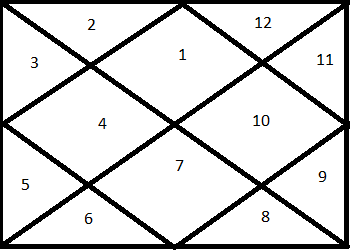Vedic Astrology: Planetary Strengths or Graha Bala
Before
analyzing the horoscope we should be able to know the strength of every planet.
Vedic astrology being the systematic science has a mathematical method of
calculating the strength of planets. These strengths help to evaluate the
magnitude of the event. For instance, if a combination indicating that the
person will be a doctor is present in two similar horoscopes, their reputation
as a doctor will be completely different depending upon the relative strength
of the planets. In the coming posts we will learn to mathematically evaluate
the relative strength of planets.
These strengths are called as 'Shadbala'
or six fold strength. The strengths are divided into 6 main categories, they
are as follows.
1.Sthanabala
or Positional Strength
2.Digbala or
Directional Strength
3.Kala bala
or Temporal Strength
4.Chesta
bala or motional Strength
5.Naisargika
bala or Natural Strength
6.Drik Bala
or Aspectual Strength
There
are certain other strengths like Residential Strength which we will discuss
after discussing 'Shadbala'. One important point to note is that Rahu
and Ketu are not at considered while calculating planetary strength because
they are not planets.
Before explaining the
Strength let us understand the unit of measurement for Strength. The main unit
is called as Rupa. A rupa is subdivided into virupas. Following formula
explains the relation between Rupa and Virupa.
1 Rupa = 60 Virupa
Now
let us understand the first type of strength i.e. Sthana Bala or Positional
Strength.
The
sthana bala is subdivided into 5 subtypes, they are as follows.
1.Uccha Bala (Strength
of planet because of being in exalted or debilitated sign)
2.Saptavargaja bala
(Relative Strength of the planet in Seven 'vargas' or divisions)
3.Yugma-ayugma
rasi-navamsa bala (Strength of planet being in even or odd sign respectively)
4.Kendradi bala
(Strength of planet being in kendra or quadrants etc.)
5.Drekkana Bala
(Strength of planet being in male or female drekkana)
Now
let us calculate different types of strengths one by one.
1.Uccha Bala
-
Every planet has its point of exaltation and debilitation. It is called as
ucchamsa and neechamsha (This is not at all related with divisional charts.) Uccha
bala is the strength that a planet possesses because of being at its ucchamsa
or in exaltation sign. Every planet at its ucchamsa has full uccha
bala( i.e.60 virupas or 1 rupa) and when at neechamsa gives 0 Ucchabala. In
between these two points a planet gives proportionate uccha bala.
For calculation of the Uccha Bala take
the difference between the longitude of the planet and its neechamsa (point of
debilitation) if the difference is more than 180 degrees then subtract it from
360 degree. Multiply the difference by 60 virupa & divide the product by
180 Degrees. The rule can be summarised as follows-
Planet's
Longitudes - Debilitation point of a planet
------------------------------------------------------------------------------------- x 60 Virupas
180 degrees (distance between the exaltation point and debilitation point of a planet.)
------------------------------------------------------------------------------------- x 60 Virupas
180 degrees (distance between the exaltation point and debilitation point of a planet.)
OR
Planet's Longitudes -
Debilitation point of a planet
--------------------------------------------------
3
Following
table shows the occhabala of planets
Planet
|
Longitude
|
Neechamsa
(Debilitation Point)
|
Difference
|
Ucchabala in Virupas
|
Sun
|
75.86
|
190
|
114.14
|
38.05
|
Moon
|
208.2
|
213
|
4.8
|
1.6
|
Mars
|
233.55
|
118
|
115.55
|
38.52
|
Mercury
|
57.81
|
345
|
72.81
|
24.27
|
Jupiter
|
63.55
|
275
|
148.55
|
49.52
|
Venus
|
31.63
|
177
|
145.37
|
48.46
|
Saturn
|
45.13
|
20
|
25.13
|
8.38
|








Jupiter Neechamsa is 275. I guess typo error
ReplyDeleteYes it was a typo. Just now fixed it. Thank you for the correction.
Delete